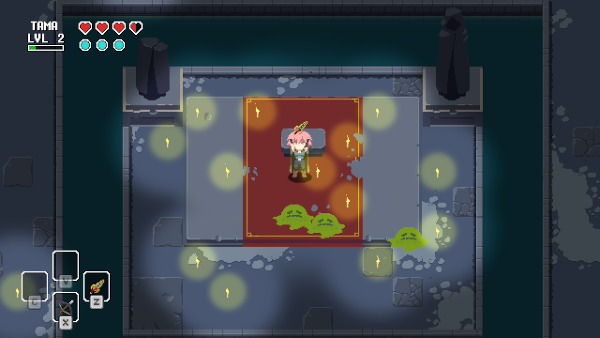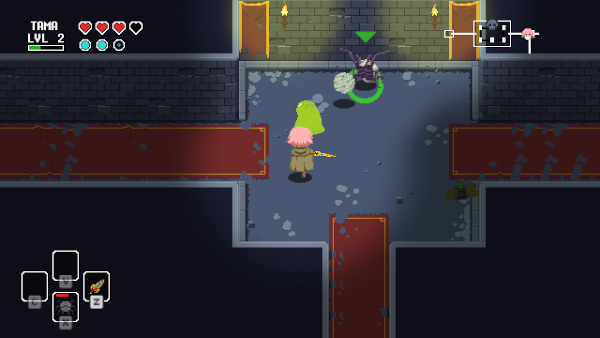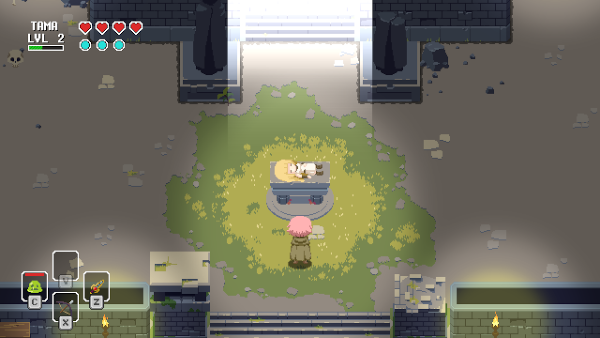Interview: Sword of the Necromancer’s Victor Pedreno
Having wildly blown past its target goal on Kickstarter, Barcelona-based Grimorio of Games‘ Sword of the Necromancer (produced and published by JanduSoft), stands out as a beautiful pixel-art ARPG with rogue-like elements, a game chasing forbidden knowledge as Tama seeks to resurrect the priestess Koko with the dark arts. With the days ticking down on the crowdfunding effort, I chatted with dev Victor Pedreno on the finer points of his work.
Erik Meyer: As Sword of the Necromancer is dungeon-crawler action RPG drawing inspiration from The Legend of Zelda: A Link to the Past and Enter the Gungeon, I’d love to hear about specific details you were inspired by and how the kernel for your project grew out of those elements. With so many titles releasing in the indie market every month, how do you pull from iconic games while adding new mechanics?
Victor Pedreno: Enter the Gungeon is an excellent game which we love, but it also has things that we think could be handled differently to make the game a little more accessible. While we love its fast pace and mechanics, we feel that at some times it’s too much for many players (which is its main point, to be a rogue-like “bullet-hell”). Enter the Gungeon is so good it has spawned a bazillion other rogue-likes with twin-stick shooter mechanics and super fast-pace, lights and bullets everywhere, so what it does, it does very well.
But for our game, we wanted to take a different approach, a more calm experience. That’s why we looked back at older games, and here’s where A Link to the Past steps into. 2D Zelda games had direct combat mostly based on hitting things with a sword, which is faster and simpler than the 3D installments (basically because there’s no need to move a camera or Z-targeting).
Nowadays, rogue-likes (or better, rogue-lites) tend to use shooting as their primary method of combat. This is no doubt influenced by games like The Binding of Isaac, Nuclear Throne, or the aforementioned Enter the Gungeon. The ones that opt for non-shooting combat have frantic battles where the character has a very wide range and doesn’t have to “aim” its attack.
We wanted to make our game in a way that, to hit an enemy, you have to put yourself very close to it, and you attack only in the direction you’re facing, not in a wide arc that covers like 180 degrees around the character. But in the same way, we didn’t want it to be as “rigid” as 2D Zelda games; that’s why our game has 8-directional movement and animations. To compensate for this, the game also helps the player a little by correcting the attack direction if there’s an enemy near.
Our aim is to make for fluid combat, which does not mean necessarily a super-fast-paced one. You can play Sword of the Necromancer in a relaxed way, as strategy and positioning of yourself, your allies, and enemies comes more into play than sheer amounts of things flying at you.
And to take advantage of that strategy, we have the summons. The character you control, Tama, can use a variety of weapons: swords, spears, axes, bows, and magic tomes (weapons that are the staple of the Fire Emblem series, which is one we also love and wanted to make a subtle reference to), but she has to find those weapons first, and chests are random (thus, not reliable). But what is always there? Enemies.
You walk around the dungeon and find an enemy that shoots energy balls at you. And you can’t do the same, because you don’t have a magic tome, so you have to fight that enemy with your close combat weapon, putting yourself in danger as it keeps shooting energy balls that, if they hit you, deal a good amount of damage. Wouldn’t it be nice to have something like that?
That’s where the monster summoning comes from. Back in the PS1 days, there was this game, Azure Dreams, which is not one of the most known PS1 games in the mainstream but over the years achieved cult classic status. In that game (which was also a dungeon crawler rogue-like with procedural dungeon generation and all that), you could take monster eggs from the dungeon enemies, raise them, and come back to the dungeon with a monster by your side, which you’d use in classical rogue turn-based battles.
We thought it would be nice to have something like that, but with a more direct approach. You see an enemy you’d want to have by your side? Fight it, defeat it and if you want, it’s yours. This also brings a “risk-reward” concept into the game. The best allies are first formidable enemies, so if you want them, you may risk losing your life in that effort.
More or less, this was our thought process while designing Sword of the Necromancer in its initial stages.

EM: Fittingly, the game uses death in a number of ways – animating fallen enemies to fight with Tama – in addition to mortality being a motivational tool (she wants to revive Koko). What is it about the dark arts that draws an audience in so completely, and as characters gain forbidden abilities, what kinds of additional problems get unlocked?
VP: The dark arts in literature have this appeal of fiddling with the natural order of things, normally to get a benefit at the cost of something very important: a sacrifice (physical or metaphorical), one’s humanity or soul… This inspires tragic stories, and everyone loves their tragic stories.
EM: Necromancers have received a range of treatments over the years, from hack-and-slash in the Diablo series to the Elric brothers sacrificing their bodies in Full Metal Alchemist. With regard to the genre, what kinds of clichés have you sought to avoid, and which aspects have you fully embraced as you’ve developed the game’s universe?
VP: In our game’s lore, the Necromancer is someone who sought eternal life defying the gods’ will (which is that everything has an end), and as a byproduct of that, found a way to bring back things from dead. Then, the Necromancer built the ever-changing dungeon to protect itself from the people who would come later to get that power for themselves.
Normally, necromancers in literature and media are skeleton-faced dudes in tunics that want to take over the world with an army of undead. In our case, it’s not like that but is instead someone who has messed with natural order and became a pariah, but at the same time has something that many people want: the power to cheat death.
We are not trying to deviate from the cliché just for the sake of doing something different, but we try to bring a new look at that. That’s also why the item that lets players revive things is a sword instead of a magical staff or a grimoire (which would be fitting, looking at the developer’s studio name). We wanted something that could be used as a weapon in a more direct way, so we choose a sword. It’s a ritual sword, so it’s not good for physical combat (in fact, in the game it deals damage scaled to the character’s magic stat, not strength).
Some people say that the main character using a sword is a cliché, while in fact we did it because we are subverting another cliché!

EM: To pull back for a minute, SOTN is being developed by Grimorio of Games and produced and published by JanduSoft, both based in Barcelona. At my time of writing, the project has wildly surpassed its Kickstarter goals (over 500%), so with regard to crowdfunding, how have the different groups involved worked together, and what does your synergy look like?
VP: Grimorio of Games is the creative team, developing the game in all its aspects (game design, programming, art, music …), while JanduSoft takes care of the “Ps”: production (planning, quality assurance), publishing, porting, and promotion.
We have worked together before, with Grimorio of Games’ previous game Super Hyperactive Ninja. That went pretty well, so this time the collaboration is even closer to get the most of it.
EM: You employ frame-by-frame animation with pixel art, which (to my experience) people only do out of love. Can you break down your visual design philosophy – palette, shading, animations, interactions, environments – and the nucleus that forms the overall aesthetic?
VP: The main aesthetic goal is to reach a pixel art style with personality. We are neither making a NES-styled nor a SNES-styled game; we are not trying to do a retro or a faux-retro aesthetic. But at the same time, we impose limits on ourselves to not break this certain aesthetic: each sprite can’t have more than a specific number of colors, shadow levels, and frames per animation. This is to ensure cohesion between them.
We are also not using particle effects anywhere in the game: it’s all drawn frame by frame. In the same way, we don’t use “half-pixels”, “diagonal pixels” or upscaled graphics, so every pixel in the game has the same size and shape.
Regarding the character and monsters’ designs in the game, we have tried to make it somewhat cute while having its share of creepy monsters (mostly bosses). We thought that having monsters that can be cute depending on how you look at them can help to see them as allies easier. It’s something that seems to work within our intended audience.

EM: The game includes many different weapon types and items, in addition to the animation of fallen enemies, and I’m interested in how you balance these options and play styles as you create levels. When you design movement algorithms and place enemies in an area, how adaptive do you expect players to be, and how essential will it be to maintain variety in the arsenal at your disposal?
VP: Weapons are basically balanced by reach, number of hits you can perform with its combo, and its charged attack. Right now, we have seen that bows can be abused easily, so we’ll have to think of something to nerf them!
But basically, weapons require you to either get very close to the enemy or be still while you are charging and aiming (thus being more susceptible to getting hit by an enemy). Summoned monsters act independently according to an AI, so even if their attacks hit usually harder than the player’s, they may not do what you want at that time, but as they are an independent entity, you can work alongside them.
Also, you can have only 3 things equipped (besides the Sword of the Necromancer, which is always assigned to one of your four slots): be it a monster, a weapon, or a passive item that grants some abilities. Individual players will find a way to build the character and play they like. For some, it will be making a little army of monsters; for others, trying to get special effects from relics may be the way.
EM: You’re working with Inés Mirás, who is composing the game’s music; often, audio gets overlooked in games or gets added as an afterthought, unintentionally changing the whole feel of a project. But in the case of SOTN, the music gives an upbeat feel that complements the visual style well. How did you get on the same page, and how do you see the sonic landscape contributing overall?
VP: We met Inés when we showcased the game at Barcelona Games World, in December 2018. We were showing a proof of concept, a demo, made in only a month. At that time, we didn’t have a single sound in the game, the controls were horrible, and all the graphics were placeholder, but the main thing was there: you could kill enemies, revive them, and use them as summons.
However, the game was very well received. We had lots of meetings and showed the game to potential investors, who liked the idea (but of course told us that there was still a lot of work to do). One of those meetings was with Inés, who at the time was looking for projects to work on as a composer, and we were looking for a composer.
We showed her the game, explained the plot and she fell in love with it. Since then, we’ve been working closely with her. We had to redo absolutely everything in the following months, so you could say that music has been developed alongside the game since its first moments.
For us, game music is the most important part besides the gameplay itself, way more than graphics. Even a game with bad gameplay can be bearable with good enough music. Also, coincidentally, Inés is fond of Celtic music, and Celtic culture is something we take much from in the game’s lore, so that has been a match made in heaven.

EM: These days, we could all use a little hope for the immortality of our loved ones. I live in the American Midwest, and you’re in Spain, but the world has gotten smaller with the current pandemic. How do you see people becoming closer, more loving, and more fragile, even as we sacrifice for the people we cherish?
VP: Here in Spain, we have been over 40 days in lockdown, and we do not have an ending date yet. Most of the team has only gone out to go shopping for supplies since March 13th, and we are all obviously working from home.
During this time, we have seen the best of people, but also the worst. Many selfish actions, many selfish people thinking that “if only I do this, it won’t be bad”. Recently, the government has accepted that people with kids can go out for an hour a day so the kids are not all day closed at home, since it can be bad for their psychological growth. The day after that was approved, whole families (despite the announcement saying that it would be a maximum of 1 adult per 3 kids) were in the streets, chatting and playing happily without respecting security distances, without wearing face masks or gloves.
This is irresponsible and will only be met with a growth in cases in the best scenario, and a growth in deaths in the worst. If we don’t take this seriously, we are only dragging out this situation longer, making our whole economy go down, and saturating our healthcare system. As long as you can, you should stay home and work from there.
As we said, we’ve also seen very good things. Many people share things over the net or even from their balconies. For example, people here go to their balconies and play games (bingo, trivia games, etc.), each one shouting from their homes. Or they play instruments or things like that.
In fact, with all this situation we have learnt that culture, be it videogames, music, movies, whatever, is invaluable.
In case you missed it, here’s the trailer:




